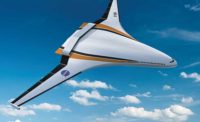Aerospace engineers around the world have been searching for new ways to make aircraft lighter and more fuel efficient. Aeroelastic wings may be the answer.
Traditionally, ailerons, leading-edge flaps and other movable surfaces are used on flexible wings to provide maneuvering and control.
“Aeroelastic wings have their composite layups tailored for the specific loading,” says Julius Bartasevicius, a manufacturing engineering research assistant at the Technical University of Munich (TUM) Institute of Aircraft Design who has been studying the technology. “[We have developed] a wing that is split into multiple sections.
“In every single section, the layup is automatically generated using an algorithm,” explains Bartasevicius. “This algorithm [ensures] that the layup (fiber alignment) properly addresses the loads that the wings experience or redistributes them.
“An example for redistributing loads could be the bending and twist coupling of the wing that is used to alleviate the gust load,” adds Bartasevicius. “By using these two mechanisms (design for load and design for load alleviation) the wing layup can be optimized more than for the traditional wings. Therefore, they became lighter.”
Bartasevicius and his colleagues are working with engineers at the German Aerospace Center to develop lightweight wings that are also extremely stable. They feature a wide wingspan, less air resistance and better energy-efficiency.
The challenge in building aeroelastic wings is the aerodynamic phenomenon known as “flutter.” Aerodynamic drag and wind gusts result in continuously increasing wing vibration, similar to a flag flying in wind.
Flutter leads to material fatigue and can even go as far as ripping off a wing. Although every wing begins to flutter at a certain speed, shorter and thicker wings have higher structural rigidity and thus higher stability. Making wings that have a wider wing span and are still exactly as stable adds much more weight.
“Flutter is a coupling of two effects: Unsteady aerodynamics and structural dynamics,” Bartasevicius points out. “To reduce flutter, both effects can be used.
“Structure can be made stiffer or masses can be tuned,” claims Bartasevicius. “Looking at it from the other side, unsteady aerodynamics can be influenced by countering it with another source of unsteady aerodynamics, that is, with outboard flap vibration (or high frequency actuation).”
The TUM engineers recently conducted a test flight to study the concept and examine how it optimizes lift behavior. It’s part of a European project called FLEXOP (flutter-free FLight Envelope eXpansion for ecOnomical Performance improvement), which is focusing on creating new ways to bring flutter under control and build lighter wings.
The super-efficient flutter wing is made out of fiberglass. When flutter occurs, the outermost flaps are deployed, functioning as dampers.
“Active flutter control still needs research done to properly understand the mechanics behind the unsteady aerodynamics of a fluttering wing,” says Bartasevicius. “In addition, high frequency actuation of a flap is not trivial, nor is the control loop (sensors, control computers and actuators).”


